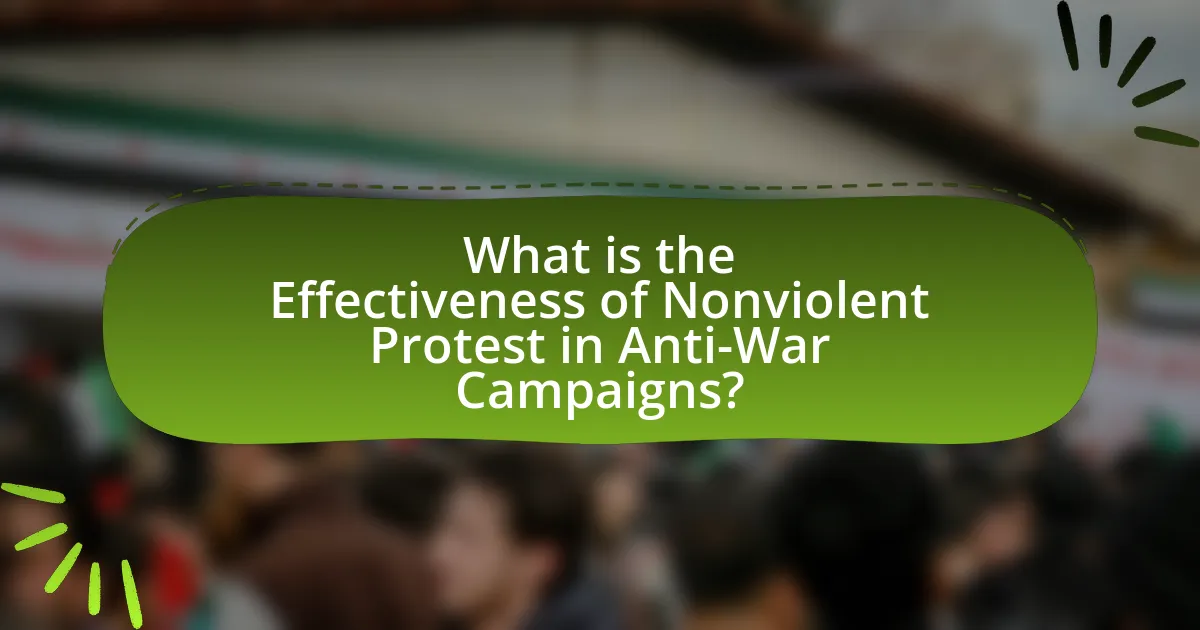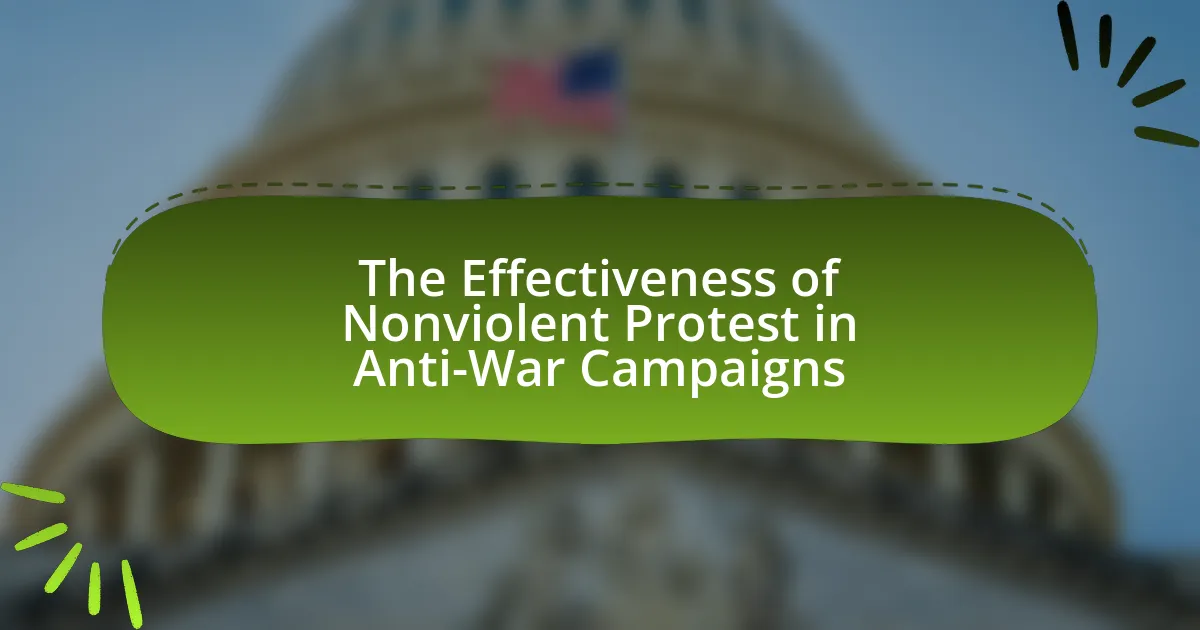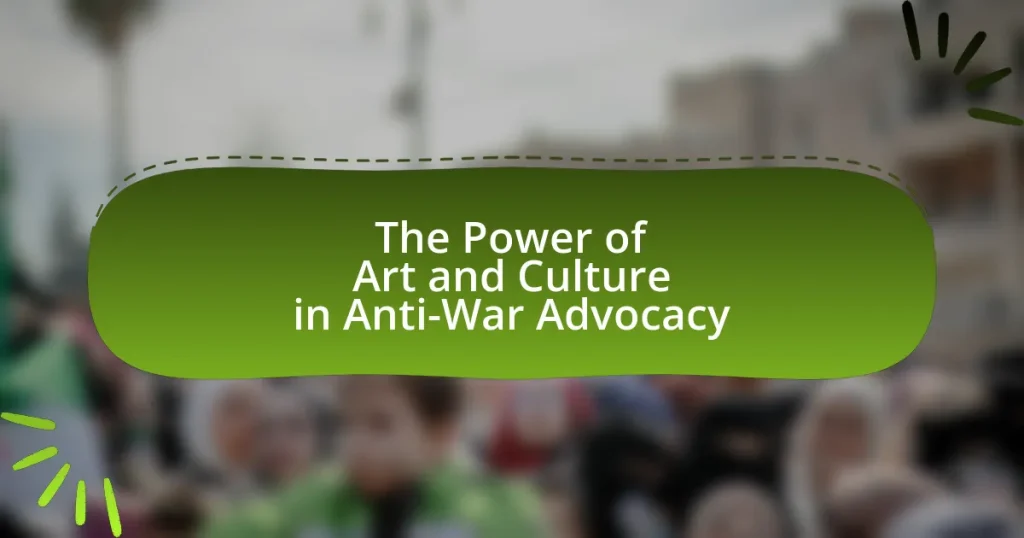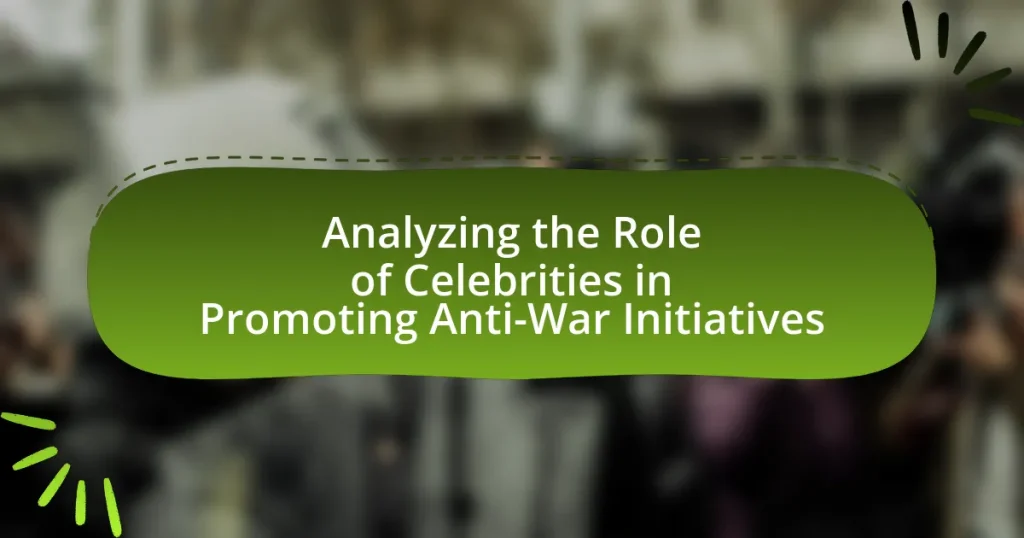The article examines the effectiveness of nonviolent protest in anti-war campaigns, highlighting its historical success and research findings that demonstrate a higher success rate compared to violent methods. Key examples include the Vietnam War protests, the Campaign for Nuclear Disarmament, and global anti-Iraq War demonstrations, which mobilized public support and influenced policy changes. The article also discusses the psychological impacts on participants and observers, the strategies employed in nonviolent actions, and the challenges faced by these movements, including government repression and public apathy. Additionally, it outlines practical tips for enhancing the effectiveness of nonviolent protests through strategic planning, clear messaging, and coalition-building.

What is the Effectiveness of Nonviolent Protest in Anti-War Campaigns?
Nonviolent protest is highly effective in anti-war campaigns, as evidenced by historical examples and research findings. Studies, such as those conducted by Erica Chenoweth and Maria J. Stephan, demonstrate that nonviolent movements are more likely to achieve their goals than violent ones, with a success rate of 53% compared to 26% for violent campaigns. Additionally, nonviolent protests can mobilize broader public support and create a moral high ground, which can pressure governments to change policies. The civil rights movement in the United States and the anti-apartheid movement in South Africa are prime examples where nonviolent strategies led to significant political change and the end of oppressive regimes.
How has nonviolent protest been utilized in historical anti-war movements?
Nonviolent protest has been a crucial strategy in historical anti-war movements, exemplified by events such as the Vietnam War protests in the 1960s. Activists employed tactics like sit-ins, marches, and peaceful demonstrations to express opposition to military actions, significantly influencing public opinion and policy. For instance, the 1969 Moratorium to End the War in Vietnam mobilized millions across the United States, showcasing the power of collective nonviolent action. This movement not only raised awareness but also pressured the government to reconsider its military involvement, ultimately contributing to the withdrawal of U.S. troops in 1973.
What are some key examples of nonviolent protests in anti-war campaigns?
Key examples of nonviolent protests in anti-war campaigns include the Vietnam War protests in the United States, the Campaign for Nuclear Disarmament in the UK, and the anti-Iraq War demonstrations globally. The Vietnam War protests, particularly the 1969 Moratorium to End the War in Vietnam, mobilized millions through peaceful marches and sit-ins, significantly influencing public opinion and policy. The Campaign for Nuclear Disarmament, initiated in the late 1950s, utilized mass rallies and symbolic actions like the Aldermaston March to advocate for nuclear disarmament, impacting government decisions. The global anti-Iraq War protests in 2003, which saw millions participate in peaceful demonstrations across various countries, highlighted widespread opposition to military intervention and played a role in shaping political discourse. These examples illustrate the power of nonviolent action in mobilizing public sentiment and influencing political outcomes in anti-war contexts.
How did these protests influence public opinion and policy?
Protests significantly influenced public opinion and policy by raising awareness and mobilizing support against war initiatives. For instance, the Vietnam War protests in the 1960s and 1970s shifted public sentiment, leading to increased skepticism about U.S. military involvement and ultimately contributing to policy changes, such as the withdrawal of troops. Polls indicated that opposition to the war grew from 26% in 1965 to over 60% by 1970, demonstrating a clear shift in public opinion. This change pressured policymakers to reconsider military strategies and engage in peace negotiations, illustrating the direct impact of nonviolent protests on both societal attitudes and governmental decisions.
Why is nonviolent protest considered effective in anti-war campaigns?
Nonviolent protest is considered effective in anti-war campaigns because it mobilizes public support and creates moral pressure on decision-makers. Historical examples, such as the Civil Rights Movement led by Martin Luther King Jr., demonstrate that nonviolent actions can attract widespread media attention and public sympathy, which in turn influences political leaders. Research by Erica Chenoweth and Maria J. Stephan in their book “Why Civil Resistance Works” shows that nonviolent movements are more likely to achieve their goals than violent ones, with a success rate of 53% compared to 26% for violent movements. This effectiveness stems from the ability of nonviolent protests to unite diverse groups, maintain legitimacy, and foster dialogue, ultimately leading to significant political change.
What psychological impacts does nonviolent protest have on participants and observers?
Nonviolent protest has significant psychological impacts on both participants and observers, fostering a sense of empowerment and collective identity among participants while promoting empathy and moral engagement among observers. Participants often experience increased self-efficacy and solidarity, as evidenced by studies showing that involvement in nonviolent movements can enhance individuals’ belief in their ability to effect change (Gaventa, 2006). Observers, on the other hand, may develop a greater understanding of the issues at stake and feel compelled to support the cause, as research indicates that witnessing peaceful demonstrations can evoke feelings of compassion and moral responsibility (Bennett & Segerberg, 2013). These psychological effects contribute to the overall effectiveness of nonviolent protests in mobilizing support and fostering social change.
How does nonviolent protest compare to violent methods in achieving anti-war goals?
Nonviolent protest is generally more effective than violent methods in achieving anti-war goals. Historical evidence shows that nonviolent movements, such as the Civil Rights Movement in the United States, led by figures like Martin Luther King Jr., successfully mobilized public opinion and resulted in significant legislative changes without resorting to violence. Research by Erica Chenoweth and Maria J. Stephan in their book “Why Civil Resistance Works” indicates that nonviolent campaigns are twice as likely to achieve their objectives compared to violent ones. This effectiveness is attributed to the ability of nonviolent protests to garner broader public support, attract diverse participation, and maintain moral high ground, which can pressure governments to change policies.

What are the key strategies employed in nonviolent anti-war protests?
Key strategies employed in nonviolent anti-war protests include civil disobedience, mass mobilization, and the use of symbolic actions. Civil disobedience involves deliberately breaking laws to challenge unjust policies, as seen in the 1960s anti-Vietnam War protests where activists engaged in sit-ins and draft card burnings. Mass mobilization refers to organizing large groups of people to demonstrate against war, exemplified by the 2003 global protests against the Iraq War, which drew millions worldwide. Symbolic actions, such as candlelight vigils and art installations, serve to raise awareness and convey messages of peace, effectively capturing public attention and media coverage. These strategies have historically proven effective in influencing public opinion and policy decisions regarding war.
What types of nonviolent actions are most commonly used?
The most commonly used types of nonviolent actions include protests, sit-ins, strikes, boycotts, and civil disobedience. Protests mobilize large groups to express dissent, while sit-ins involve occupying a space to disrupt normal activities. Strikes halt work to demand change, and boycotts withdraw support from businesses or entities to exert economic pressure. Civil disobedience entails deliberately breaking laws to highlight injustice. Historical examples, such as the Civil Rights Movement in the United States, demonstrate the effectiveness of these actions in achieving social and political change.
How do marches and sit-ins contribute to the effectiveness of anti-war campaigns?
Marches and sit-ins significantly enhance the effectiveness of anti-war campaigns by mobilizing public support and drawing media attention. These forms of nonviolent protest create visible demonstrations of dissent, which can influence public opinion and pressure policymakers. For instance, the 1969 Moratorium to End the War in Vietnam mobilized millions across the United States, showcasing widespread opposition to the war and leading to increased media coverage that highlighted the anti-war sentiment. This visibility can lead to greater engagement from citizens, encouraging them to participate in the movement and advocate for policy changes. Additionally, historical data indicates that nonviolent movements, including marches and sit-ins, are more likely to achieve their goals compared to violent protests, as evidenced by the success of the Civil Rights Movement in the United States.
What role does civil disobedience play in nonviolent protests?
Civil disobedience serves as a crucial mechanism within nonviolent protests by actively challenging unjust laws and policies while maintaining a commitment to nonviolence. This form of protest highlights moral opposition to specific government actions, drawing public attention and fostering dialogue about social injustices. Historical examples, such as the Civil Rights Movement led by Martin Luther King Jr., demonstrate that acts of civil disobedience, like sit-ins and marches, effectively mobilized public support and pressured authorities to enact change. The strategic use of civil disobedience in nonviolent protests has been shown to increase visibility and urgency around issues, ultimately contributing to significant legislative and social reforms.
How do organizers mobilize support for nonviolent anti-war protests?
Organizers mobilize support for nonviolent anti-war protests by utilizing grassroots strategies, social media campaigns, and coalition-building efforts. Grassroots strategies involve engaging local communities through meetings, workshops, and outreach to raise awareness about the issues at stake, which fosters a sense of collective action. Social media campaigns amplify their message, allowing organizers to reach a broader audience quickly; for instance, platforms like Twitter and Facebook have been instrumental in mobilizing participants for events such as the 2003 Iraq War protests, which saw millions worldwide take to the streets. Coalition-building with other organizations, including labor unions, environmental groups, and civil rights organizations, strengthens the movement by pooling resources and diversifying the participant base, as evidenced by the collaboration seen in the United for Peace and Justice coalition. These methods collectively enhance visibility and participation in nonviolent anti-war protests.
What communication strategies are effective in rallying participants?
Effective communication strategies for rallying participants include clear messaging, emotional appeals, and inclusive dialogue. Clear messaging ensures that the objectives and goals of the protest are easily understood, which can increase participant engagement. Emotional appeals, such as storytelling or highlighting personal experiences, can motivate individuals to join the cause by creating a sense of urgency and connection. Inclusive dialogue fosters a sense of community and belonging, encouraging diverse voices to contribute, which can enhance the overall impact of the movement. Research indicates that campaigns employing these strategies, such as the Civil Rights Movement, successfully mobilized large groups through effective communication.
How do social media and technology enhance the reach of nonviolent protests?
Social media and technology enhance the reach of nonviolent protests by facilitating rapid information dissemination and enabling global connectivity. Platforms like Twitter and Facebook allow organizers to share real-time updates, mobilize supporters, and amplify their messages to a wider audience, often leading to increased participation. For instance, during the Arab Spring, social media played a crucial role in coordinating protests across multiple countries, demonstrating its effectiveness in uniting diverse groups under a common cause. Additionally, technology enables live streaming and video sharing, which can draw international attention and support, as seen in the Black Lives Matter movement, where footage of protests reached millions, raising awareness and prompting discussions on social justice.

What challenges do nonviolent protests face in anti-war campaigns?
Nonviolent protests in anti-war campaigns face significant challenges, including government repression, public apathy, and media misrepresentation. Government repression often manifests through legal restrictions, police violence, or surveillance aimed at deterring participation in protests. For instance, during the Vietnam War, activists faced arrests and violent crackdowns, which hindered the effectiveness of their movements. Public apathy can limit the reach and impact of nonviolent protests, as many individuals may feel disconnected from the issues or believe that their participation will not lead to change. Additionally, media misrepresentation can distort the narrative surrounding nonviolent protests, framing them as ineffective or radical, which can alienate potential supporters. Historical examples, such as the anti-nuclear protests in the 1980s, illustrate how these challenges can undermine the goals of nonviolent movements.
What are the common criticisms of nonviolent protest methods?
Common criticisms of nonviolent protest methods include perceptions of ineffectiveness, the potential for co-optation by mainstream politics, and the risk of complacency among supporters. Critics argue that nonviolent actions often fail to achieve immediate results, as seen in various historical contexts where violent uprisings led to quicker political change. Additionally, some assert that nonviolent movements can be absorbed into existing political structures, diluting their original goals, as observed in the civil rights movement where some objectives were compromised for broader acceptance. Furthermore, critics contend that reliance on nonviolent methods may lead to a false sense of security among activists, potentially reducing the urgency for systemic change, which can hinder long-term progress.
How do opponents of nonviolent protest argue against its effectiveness?
Opponents of nonviolent protest argue that it is often ineffective in achieving substantial political change. They contend that nonviolent methods can be easily ignored or suppressed by authorities, leading to minimal impact on policy or social structures. For instance, critics point to historical examples such as the civil rights movement, where despite significant nonviolent efforts, systemic racism persisted for decades. Additionally, opponents assert that nonviolent protests may fail to mobilize sufficient public support or media attention, which can diminish their potential to influence decision-makers. They argue that more aggressive tactics may be necessary to provoke a response from entrenched power structures, as seen in various revolutionary movements where violence has led to quicker political outcomes.
What internal challenges do nonviolent movements encounter?
Nonviolent movements encounter several internal challenges, including maintaining unity among diverse participants, managing differing ideologies, and sustaining motivation over time. Unity can be difficult due to varying goals and strategies among members, which can lead to fragmentation. For instance, the Civil Rights Movement in the United States faced internal divisions between more radical factions and those advocating for gradual change. Differing ideologies can create conflicts regarding the methods of protest, as seen in the anti-apartheid movement in South Africa, where some groups favored nonviolent resistance while others supported armed struggle. Additionally, sustaining motivation is a challenge, particularly during prolonged campaigns, as seen in the anti-war protests during the Vietnam War, where activists struggled to maintain engagement amidst public apathy and government repression. These internal challenges can significantly impact the effectiveness and cohesion of nonviolent movements.
How can nonviolent protests overcome obstacles to effectiveness?
Nonviolent protests can overcome obstacles to effectiveness by employing strategic planning, broad coalition-building, and maintaining public support. Strategic planning involves identifying clear goals and methods that resonate with a wide audience, which can enhance participation and visibility. For instance, the Civil Rights Movement in the United States effectively utilized nonviolent tactics to draw national attention to racial injustices, leading to significant legislative changes. Broad coalition-building allows diverse groups to unite under a common cause, amplifying the movement’s reach and impact. The anti-apartheid movement in South Africa exemplified this, as various organizations and individuals came together to challenge systemic oppression. Maintaining public support is crucial; nonviolent protests that emphasize empathy and shared values can foster a positive public perception, making it harder for authorities to dismiss or suppress the movement. Research indicates that nonviolent campaigns are more likely to succeed when they maintain high levels of public engagement and support, as seen in the Arab Spring uprisings.
What strategies can be employed to maintain momentum in nonviolent campaigns?
To maintain momentum in nonviolent campaigns, organizers can employ strategies such as consistent communication, coalition-building, and strategic planning. Consistent communication ensures that supporters remain informed and engaged, which is crucial for sustaining enthusiasm and participation. For example, the Civil Rights Movement utilized regular updates through newsletters and community meetings to keep momentum alive. Coalition-building involves forming alliances with other groups to broaden support and resources, as seen in the anti-apartheid movement, where diverse organizations united to amplify their impact. Strategic planning includes setting clear, achievable goals and timelines, allowing campaigns to adapt and respond to challenges effectively, as demonstrated by the successful tactics used during the Vietnam War protests. These strategies collectively reinforce the campaign’s objectives and help maintain public interest and involvement over time.
How can coalitions with other movements enhance the impact of nonviolent protests?
Coalitions with other movements can enhance the impact of nonviolent protests by amplifying voices, increasing resources, and broadening the audience. When diverse groups unite, they create a larger platform that attracts more media attention and public interest, as seen in the Civil Rights Movement, where alliances with labor unions and religious organizations strengthened the message and reach. Additionally, pooling resources such as funding, volunteers, and expertise allows for more organized and sustained actions, which can lead to greater visibility and effectiveness. Historical examples, like the collaboration between anti-war activists and civil rights groups during the Vietnam War, demonstrate how such coalitions can mobilize larger crowds and create a more formidable presence, ultimately influencing public opinion and policy changes.
What practical tips can enhance the effectiveness of nonviolent protests in anti-war campaigns?
To enhance the effectiveness of nonviolent protests in anti-war campaigns, organizers should focus on strategic planning, clear messaging, and community engagement. Strategic planning involves selecting high-visibility locations and timing protests to maximize media coverage, as seen in the 2003 Iraq War protests, which drew millions globally. Clear messaging ensures that the goals of the protest are easily understood, which can be reinforced through slogans and visual symbols, like the peace sign, that resonate with the public. Community engagement is crucial; building coalitions with diverse groups increases participation and amplifies voices, as demonstrated by the Civil Rights Movement’s collaboration with various organizations. These practical tips, grounded in historical examples, can significantly improve the impact of nonviolent protests in anti-war efforts.



